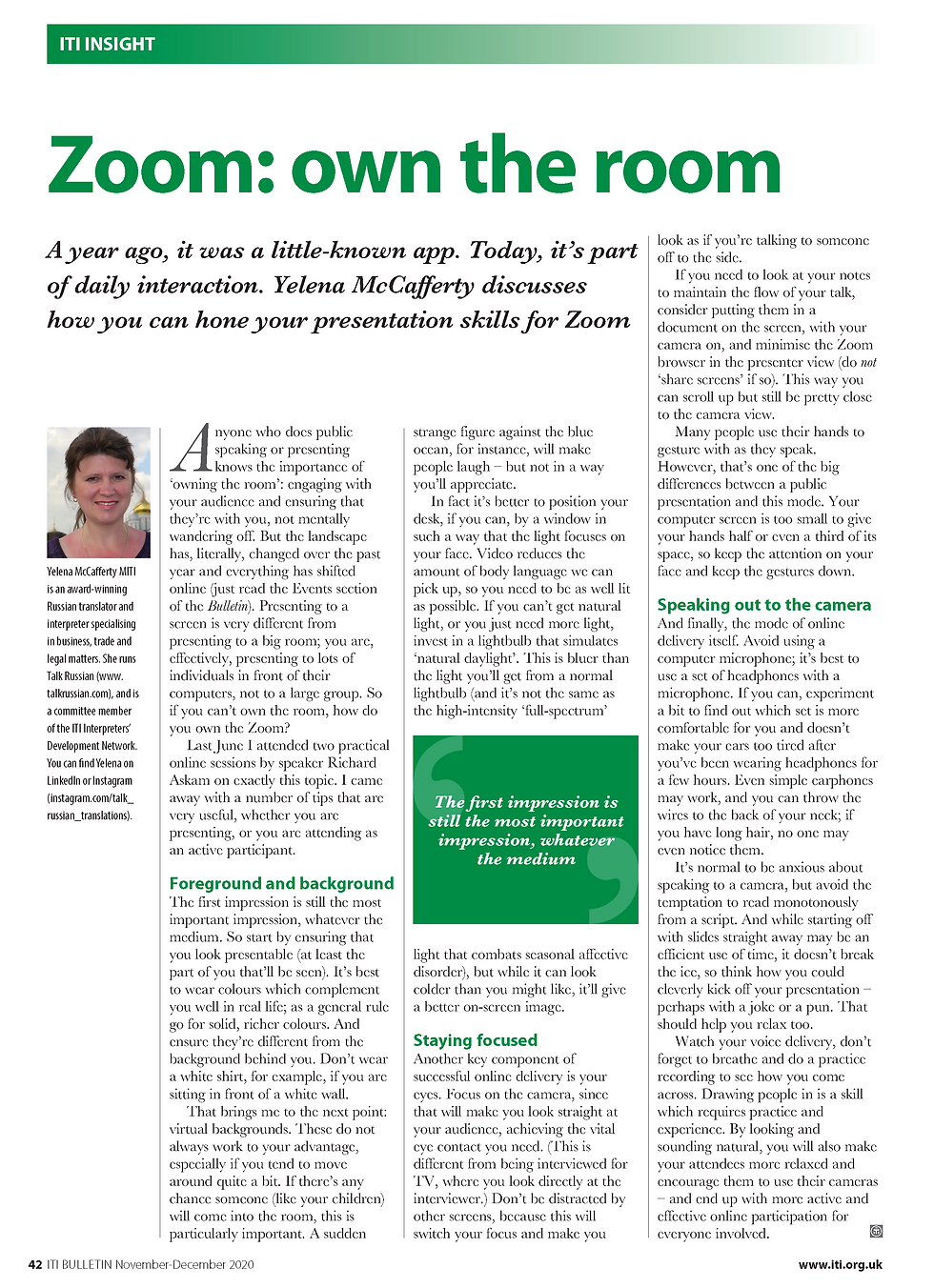Own the room on Zoom
- Yelena McCafferty

- Nov 4, 2020
- 4 min read
Updated: Jan 11, 2021
Those of us with public speaking experience know the importance of owning the room. You engage with the audience and make them respond to what you are saying. There can be nothing worse than boring your listeners, hence it’s paramount to hone your presentation skills. However, with the pandemic dictating new rules and restrictions, our environment has changed, which is true for working, business promotion and active learning.
Some scheduled events have been transferred online and even more have been released, with Zoom being the most popular platform. So how do you own the Zoom when you can’t own the room? Last June I attended two practical online sessions by Richard Askam: Own the Zoom – Presenting For Success. I find his tips useful for those of us doing online presentations as language experts and for attendees of webinars or online conferences where active participation is expected.
First things first – make yourself look and sound presentable. Experiment with clothes colours, it’s best to wear colours which compliment you well in real life, go for solid richer colours, different from the background colour. Don’t wear a white shirt, for example, if you are sitting against a white wall.
That brings me to the next point of virtual backgrounds. These do not always work to your advantage, especially if you tend to move around quite a bit or if someone suddenly happens to enter your room and in a virtual background of the blue ocean for example this will look ridiculous, albeit funny.
Lighting is another requirement to sort out; video reduces the amount of body language we can pick up and if people can’t see you because you’re in the dark, you are losing a vital channel of communication. So get yourself into the light – put your desk in front of the window so the light targets your face. If you don’t have this option, invest in an inexpensive light ring that sheds natural daylight.
Next is sound. Avoid using a computer microphone, it’s best to use a set of headphones with a mic; experiment a bit which set is more comfortable for you and doesn’t make your ears too tired after wearing headphones for a few hours. Even simple earphones may work, and you can throw the white wires to the back of your neck: if you have long hair, no one might even notice you are wearing earphones.
Another key component of successful online delivery is your eyes. You must focus on the camera as that will make you look straight at your audience, achieving that vital eye contact. If you are using split screens, don’t fall into the trap of looking at the one which hasn’t got your live camera. It will make you look as if you are talking sideways all the time, and this means you are losing the connection with your viewers. Even if you need to look at your notes to maintain the flow of your talk, consider having those notes in a document on the screen with your camera on and minimise the Zoom browser in the presenter view. This way you will have sight of your notes as you scroll them up and also see the presentation window which should be fairly close to where your camera is positioned.
Watch your hands, even though they are part of our body language, don’t give them too much prominence, a computer screen is too small to give your hands half or even a third of that space, and you don’t have the luxury of presenting in a room or on a stage where you have all the space around you to manage.
And finally, the mode of online delivery itself. Anxiety of speaking to a camera is similar to anxiety of public speaking and it’s absolutely crucial to relax and be yourself. You need to come across natural, and the way to achieve it is to be authentic. People see through copycats, imitating others with few own ideas wins few hearts and doesn’t help building relationships.
Script reading is a no-no, make your delivery conversational; starting off with slides straight away may be an efficient use of time but it doesn’t break the ice, so think how you could cleverly kick off your presentation, with a joke or a pun perhaps. It should help you relax too. The first impression is still the most important impression, even on a video call.
Watch your voice delivery, don’t forget to breathe, use the power of the pause and do a practice recording to see how you come across. Drawing people in is a skill which requires practice and experience. By looking and sounding natural, you will also make your attendees more relaxed, encourage them to switch on their own cameras, which should in itself result in a more active and effective online participation.
A version of this article appeared in the Bulletin – the magazine published by the Institute of Translation and Interpreting – in the November-December 2020 issue, Page 42.

[Tip: if you require a Russian interpreter for your Zoom meeting, get in touch with us on 0207 0436940 or email enquiry@talkrussian.com.]







Owning the room on Zoom is a whole new challenge-capturing attention through a screen takes real skill and confidence. For me, part of that confidence comes from feeling good about how I look. Since getting scalp micropigmentation for men, I’ve noticed a boost in how I carry myself on camera. It’s subtle but powerful-definitely a great move for anyone wanting to make a strong impression, both online and offline.